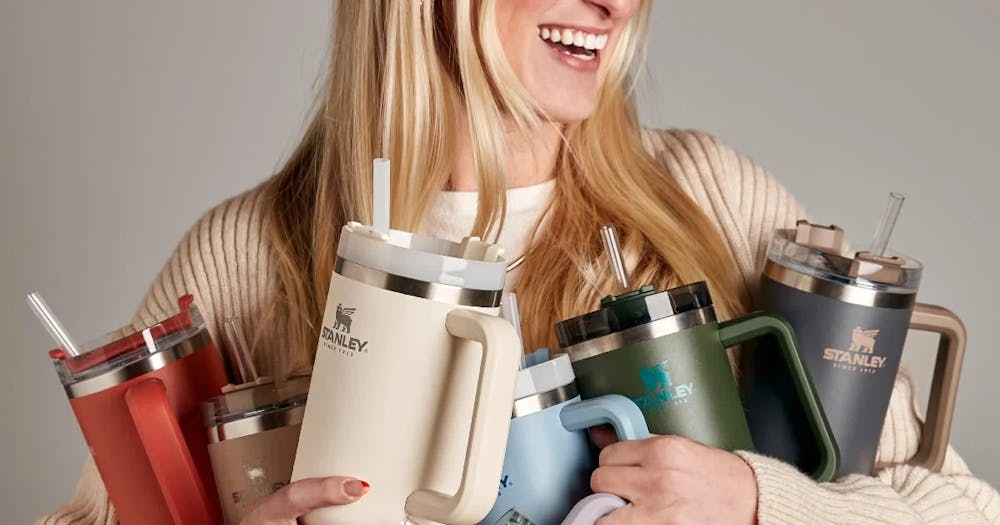Are you an “it girl”, or are you a “clean girl” complete with a slicked-back bun, an Alo matching set and gold hoops? Are you a pink Pilates princess lacing pink ribbons in your hair, showcasing a lululemon Define jacket, platform UGGs and an Equinox membership? The categorization of the female identity can be fun when looking for a way to rebrand for the new year, but I often wonder: how much of the female identity has become rooted in consumption?
Young western women do not spend money to experience, but rather to embody. The purchase of a new workout set is not just clothing, but rather a representation of a lifestyle of health and opulence. Maybe you’ll purchase a new water bottle–perhaps the newest Stanley tumbler–and some new sneakers to pair with it. Anything that plays into this idealization of fitness will be bought, and surely thereafter you will leap into the newfound identity of a “gym girl.”
When I see “girl therapy” slideshows on TikTok showcasing a new set of acrylics, a recent shopping spree and Gilmore Girls screen caps, it reminds me that American women have been conditioned into becoming a capitalist wet dream. We try on stereotyped labels like costumes, shedding our skin every few months according to the trend cycle. We call them our “eras”-- another way of highlighting the fleeting nature of our identities. Our sense of self has become tied to materialism and what purchases make up the newest aesthetic–purchases that only worsen the nation’s epidemic of overconsumption.
Even the simple societal experience of being a woman is tied to purchasing power: hair, makeup, nails, skincare, fitness–routines on which women need to consistently spend money to gain societal acceptance as a woman. A core aspect of female culture in the western world is to be exploited by advertising companies for profit. It’s rooted and found in nearly every media reference and trend directed at us, and the concept of “girl therapy” is yet another reminder of that, no matter how fun it may be.
It also concerns me when I notice how young girls have begun to invest their worth in consumption. As I scrolled through TikTok this past holiday season, I saw a slew of young girls–some as young as 10 years old–giving “hauls” of what presents they received. I noticed how they stare dead-eyed into the camera as they give monotonous-yet-thorough descriptions of the new product they saw their favorite influencer recommend in their latest “get ready with me” video. I saw other videos posted from employees of Sephora noticing this recent surge in young girls influenced to purchase skin care products that include unnecessary de-aging ingredients, such as retinol.
This made me begin to feel ancient as I remembered the absolute magic and elation I felt when I was little, opening an American Girl doll on Christmas morning with my sister (my Julie Albright shaped me into the woman I am today). Children used to discover possibilities and fun that lay in imagination with products such as these toys. Now, more value is placed on having the ability to list a brand name in a TikTok haul.
As the age of the most popular influencer becomes younger and younger, it becomes more difficult to keep up with today’s trends. Although the internet has been churning out increasingly rapid trend cycles for years, their lifespan has been shrinking at the same rate as our attention spans. Trends that would have otherwise lasted for years are now declared old news--or worse, “cheugy”--within days. While the unsustainable pace of these trends may be mind-numbing for consumers, they are great for business as they compel consumers to never stop buying.
TikTok trend cycles are attempting to remain on the cutting edge of uniqueness, while flattening all forms of individuality into a carefully selected collection of Amazon Storefront-shoppable products that formulate a “-core” or “girl”. In a society where women are often pressured to express an identity, it’s no wonder young girls have begun to turn to fast fashion companies such as the TikTok Shop to develop their sense of style–or select an influencer to develop it for them.
As life under capitalism feels increasingly alienated and social institutions fall into continuous decline, these trends have begun to feel like a confused attempt to reconcile individualism with a desperate need for community. Women used to be able to discover community in groups, organizations, sororities, religion and cultural institutions. The further that secular society strays from communities, the more women feel a need to try on fleeting identities through consumption to feel as though they are part of something greater.



The Slate welcomes thoughtful discussion on all of our stories, but please keep comments civil and on-topic. Read our full guidelines here.